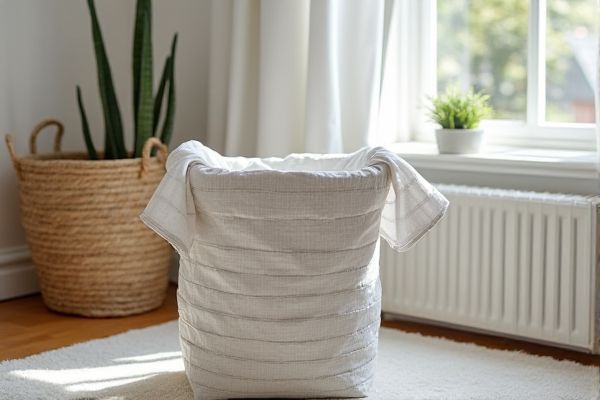
Laundry baskets are typically open containers that allow for easy transport of clothes, while laundry hampers often feature lids and ventilation to contain odors and keep dirty laundry out of sight. Discover which option best suits Your home organization needs by reading the rest of the article.
Table of Comparison
| Feature | Laundry Basket | Laundry Hamper |
|---|---|---|
| Material | Plastic, woven, mesh | Fabric, wicker, wood, plastic |
| Portability | Lightweight, easy to carry | Generally bulkier, sometimes with handles |
| Design | Open top, rigid structure | Often with lid, soft or rigid body |
| Capacity | Medium to large | Varies; often larger for sorted laundry |
| Use | Transporting dirty or clean laundry | Storing dirty laundry until wash |
| Ventilation | Good air flow due to holes or mesh | Varies; fabric hampers allow airflow, others less so |
| Common Locations | Laundry rooms, bathrooms | Bedrooms, bathrooms, laundry rooms |
Introduction: Understanding Laundry Baskets and Hampers
Laundry baskets and laundry hampers serve distinct purposes in managing dirty clothes, with baskets typically being portable containers used for transporting laundry, while hampers are primarily stationary storage units designed to hold laundry until washing. Laundry baskets often feature lightweight materials like plastic and handles for easy carrying, enhancing convenience during laundry routines. In contrast, hampers may incorporate compartments or lids to organize and conceal clothes, maintaining tidiness in living spaces.
Key Differences Between Laundry Baskets and Hampers
Laundry baskets are typically open, lightweight containers designed for easy transport of clothes, while laundry hampers often feature lids and ventilation to contain odors and moisture. Hampers usually serve as stationary storage units to hold dirty laundry until wash day, whereas baskets are more versatile for both collecting and carrying clothes. Understanding these key differences helps you choose the ideal laundry solution for your home's organization and hygiene needs.
Materials Used: Durability and Design
Laundry baskets commonly feature durable plastic or woven synthetic fibers, offering lightweight construction and easy cleaning, while laundry hampers often utilize fabric materials supported by wooden or metal frames, providing breathable storage and aesthetic appeal. Plastic baskets excel in water resistance and sturdiness, suited for heavy loads, whereas fabric hampers prioritize ventilation, reducing odors and mildew risk. Design variations reflect functional needs, with baskets favoring portability and hampers emphasizing organized storage and style integration into home decor.
Size and Capacity Comparison
Laundry baskets typically offer smaller sizes ranging from 1 to 2 bushels in capacity, ideal for transporting daily loads of clothes. Laundry hampers usually have larger capacities, often between 2 to 3 bushels, designed for collecting and storing laundry in one place. The increased size of hampers accommodates bulkier items and extended laundry cycles, providing greater convenience for sorting and organizing garments.
Portability and Ease of Use
Laundry baskets typically offer superior portability with built-in handles and lightweight materials, making them easy to carry across different rooms or to laundry facilities. Laundry hampers, often designed with rigid frames or taller structures, prioritize capacity over portability, which can make them less convenient to move when fully loaded. Choosing between the two depends on the balance needed between ease of transport and storage efficiency in your laundry routine.
Ventilation and Odor Control Features
Laundry baskets typically have open-weave or perforated designs that enhance ventilation, which helps prevent moisture buildup and reduces odor accumulation. Laundry hampers often incorporate mesh panels or breathable fabric liners to allow airflow, further aiding in odor control and keeping clothes fresher. Choosing between the two depends on the specific ventilation features, as hampers with better airflow can be more effective in odor prevention.
Best Uses for Laundry Baskets
Laundry baskets are best suited for transporting clothes due to their lightweight design and sturdy handles, making them ideal for carrying laundry to and from washing machines or laundromats. Their open-top structure provides excellent ventilation, preventing odors and mildew buildup, which is crucial for damp or soiled clothes. Unlike laundry hampers designed primarily for storage, baskets offer greater portability, perfect for daily laundry tasks and quick clothing organization.
Best Uses for Laundry Hampers
Laundry hampers are best used for sorting and organizing dirty clothes before washing, often featuring compartments for separating colors, delicates, and heavy fabrics. Their sturdy construction and breathability help reduce mildew and odors by allowing airflow while clothes are stored. Ideal for bedrooms and laundry rooms, hampers streamline the laundry process by keeping garments tidy and easy to transport to washing machines.
Factors to Consider Before Purchasing
When choosing between a laundry basket and a laundry hamper, consider the size and capacity needed to accommodate your laundry volume efficiently. Evaluate the material durability and ventilation features to prevent odor build-up and ensure easy cleaning. Your space availability and portability requirements are essential factors to ensure convenience during laundry collection and transport.
Conclusion: Choosing the Right Laundry Solution
Choosing the right laundry solution depends on your space, style preferences, and functionality needs. Laundry baskets offer portability and ease for carrying clothes, while hampers provide organized storage and often include compartments for sorting laundry. Consider your daily routine to determine which option best suits your lifestyle and keeps your laundry area tidy.
 homyna.com
homyna.com